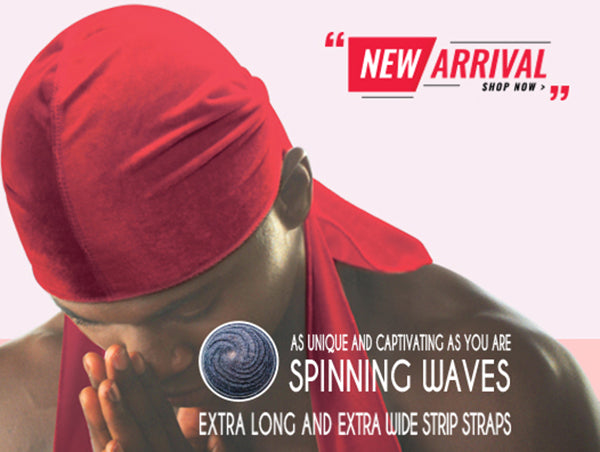The Renaissance of the Durag
What happens when black people take control of their own narratives.
DECEMBER 26, 2018
A man with dark skin turned the color of charcoal by a black-and-white filter stands broadly, eyes gazing upward at something I can’t see. A dove rests above his head with its wings stretched wide. The man's chest is bare, except for a thin, gold chain across his clavicle. A cartoonishly large teardrop escapes from his left eye, outlined in white. Tied expertly around his head is a black durag, the bottom tails flapping with the regality of a pharaoh.
This image has been the wallpaper on my iPhone for months. I don't know who the artist is (I stole it from a friend’s Insta story), but the way it makes me feel is so familiar. Feelings of pride and admiration. When I look at my screen, I am reminded of the durag's functionality; how it can finesse and protect hairstyles. But beyond that, durags are also an expression of artistry and creativity bubbling within black communities around the globe.
People of color are leading the charge to reclaim the durag, and redefine it in their own terms.
Images of black people, particularly black men, wearing durags have been part of our cultural consciousness for some time. Like many other styles and traditions chosen by black people, mainstream society predictably labeled the durag as something criminal and crude. But now people of color are leading the charge to reclaim the durag, and redefine it in their own terms. In art, music, and fashion, durags are being embraced as a symbol of divinity and diaspora, a marker of identity and existence, and a tribute to a black tradition that should no longer be ridiculed but revered.
Although there is no one origin of the durag, according to The New York Times, William J. Dowdy is known for popularizing it with So Many Waves, a brand that started in 1979. Darren Dowdy, William’s son and current president of the company, told The New York Times earlier this year that durags were first called “tie downs.” They were, and still are, used to keep curls and coils from springing back up after they were brushed down. The end result? A head of hair that resembles a sea of uniform waves. Durags can also prevent cornrows and braids from frizzing and keep locs neat. In the aughts, some of our favorite rappers brought visibility to durags in the mainstream media: Nelly, 50 Cent, Cam'Ron, and Ja Rule are a mere few who proudly wore theirs as a fashion statement. They rocked durags with suits, jeans, and jerseys, and underneath fitted caps. The varied ways they wore durags were a testament to their versatility, their fashionable functionality.
In spite of the obvious practical uses for durags, black men were, and still are, often labeled as thuggish and low-class when they wear them. In a 2017 GQ article, writer Brian Josephs explainedthat durags share a similarity with the head wrap, which many black women wear to protect their hair, for aesthetic appeal, or to cover their hair for religious reasons. In late-1700s New Orleans, the Tignon Laws required women of African descent to wear head wraps, according to Broadly. This was intended to suppress their beauty and physically distinguish their slave status. Similarly, in 2001, the NFL banned players from wearing durags and bandanas, but permitted skullcaps (if they showed team colors and logos). The NFL claimed the intention was to enforce a more uniform dress code, but the decision seemed rather, well, racist, as black players primarily wear durags. The NBA followed suit in 2005, around the time Allen Iverson became popular for wearing durags on the court, according to GQ.
The durag's rocky introduction to mainstream culture aside, today the durag's legacy is alive and well in the black community. Vann R. Newkirk II’s Durag History Week on Twitter is a tribute to public figures and cultural moments that celebrate the cloth. In June, Joseph Headen created the first Durag Fest at the black-owned gallery BLKMRKT in Charlotte, North Carolina, creating a ballroom for durags of all lengths and cuts. Videos of young black men (and some women, too) doing "wave checks" have gone viral on social media, and are hypnotic to watch. Each participant, sometimes in a large group, sometimes alone, dramatically unties their durag on camera to reveal — with much fanfare and plenty of hype — the waves hiding underneath. At some colleges, wave checks are bona fide social events.
Durag luxury brands have erupted across Instagram, with the scarf used as a storytelling device for redefining black identity through fantasy and design. Dü by Ren Jett uses effervescent patternsand lengthened fabrics to capture the spirit of those who wear their designs. L’Echanteur, a clothing brand started by twins in Brooklyn, renders durags in exuberant prints while maintaining a rugged vibe. Cut from denim, velvet, and silk, these durags are intended to last “for hundreds of years,” like heirlooms given from one generation to the next.
In the aughts, it was hard to imagine seeing durags in "polite" company, but they are now visible in places where we, and durags, were once unwelcome.
Over the past few years, celebrities have also been doing their part to reclaim the durag and let it stand in its inherent chicness. In the aughts, it was hard to imagine seeing durags in "polite" company, but they are now visible in places where we, and durags, were once unwelcome. In 2014, Rihanna wore a Swarovski crystal-encrusted durag to match her equally blingy Adam Selman dress to collect her CFDA Fashion Icon award. That night, she showed the world that the head tie can not only be elegant, but serve as the perfect piece to complete a now-iconic look. Two years later, Rihanna wore a durag during her VMAs performance of “Rude Boy,” and adorned her models in durags for her Fenty X Puma fashion show in spring 2017.
At the 2018 Met Gala, Solange — draped in a glossy onyx Iris van Herpen fall 2012 couture piece with a sculptural bottom — interpreted the durag as a heavenly headpiece. Underneath a braided halo, she wore a black durag with a super long back flap. At the hem of the flap were the words, "My God wears a durag." This public statement finally inaugurated durags into a realm of sanctity.
Solange's sister, Beyoncé, with hubby Jay-Z, juxtaposed women in flowing white durags below Jacques-Louis David’s “Portrait of Madame Récamier” in their music video for "Apeshit." The video forces the viewer to acknowledge the lack of black bodies in esteemed art spaces, and reconfigure how we determine what’s beautiful enough to enter those culturally sacred spaces.
In the art world, John Edmonds's photography depicting men in durags illustrates a delicate romance between the translucent scarf and the men who wear them. The figures become majestic and achingly tender, a side of black masculinity the media doesn’t instinctually portray. We’re so accustomed to seeing a durag-wearing black man presented as someone to mistrust and fear, as if covering one’s head is evidence of villainy rather than virtuosity.
Blood Orange’s “Jewelry” song and music video explore and challenge the negative images associated with black men wearing durags. Together with Janet Mock, they exalt blackness as jewelry in itself. The other side of “Jewelry” is a metaphor for black resistance. Blood Orange (whose locs are almost always wrapped in a durag) dances in peaceful solitude in a park, illustrating soft black masculinity and gender fluidity in nature. Meanwhile, an angel with an ivory durag hangs out of the window on the passenger side of a car, conjuring images of countless black men who are murdered by police in their own vehicles. Here, the durag takes on a holy role, standing in stark distinction against the dubious stereotypes that have been built around it.
Sharing and controlling the narrative around pieces of black culture in public, prestigious, and once privatized spaces allows us to shatter the misconceptions behind them, and humanize the people who practice them. Ultimately, we normalize these pieces into essential aspects of our culture — not a condition or exception that can lead people to further subcategorize












